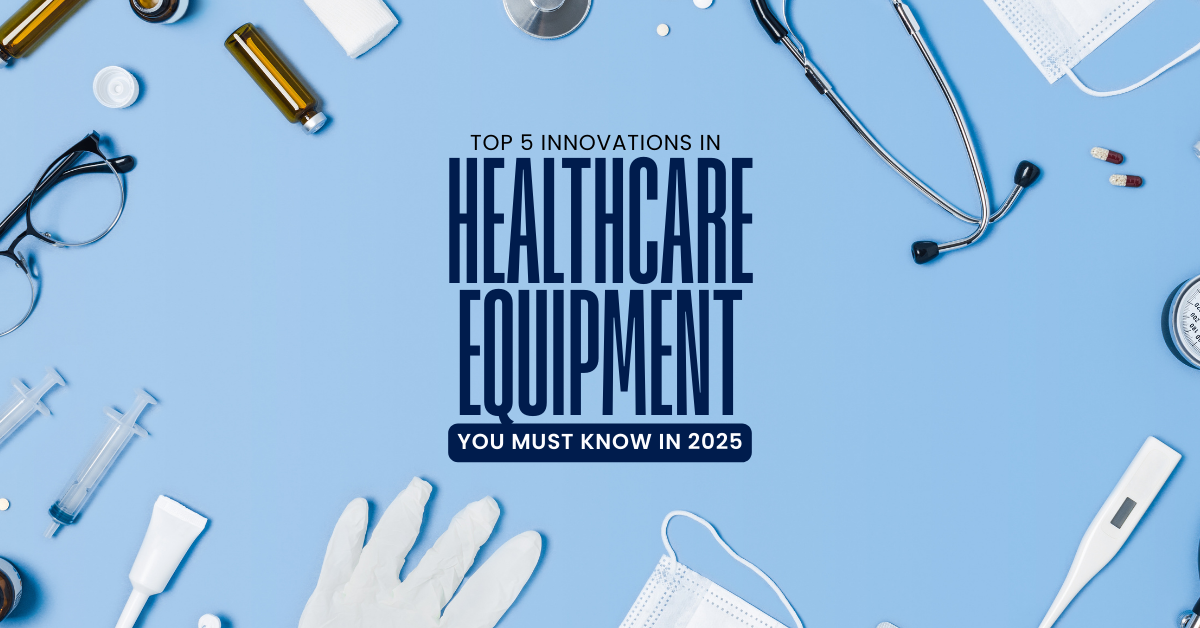Top 5 Innovations in Healthcare Equipment You Must Know in 2025

The year 2025 marks a revolutionary phase in global healthcare. With the integration of smart technologies, AI-powered tools, and real-time data access, healthcare equipment is no longer limited to diagnostics and monitoring—it's transforming the very foundation of patient care and delivery. Below are the top five innovations in healthcare equipment in 2025 that are not only enhancing clinical accuracy but also redefining the patient experience.
1. AI-Integrated Diagnostic Equipment: Precision Beyond Human Capability
Artificial Intelligence (AI) has become the backbone of diagnostic equipment in 2025. Modern imaging machines—MRIs, CT scans, and ultrasounds—are now embedded with deep learning algorithms that not only process images but interpret them in real-time.
Key advancements include:
- AI-based radiology assistants that instantly detect early signs of cancer, fractures, and neurological abnormalities.
- Equipment powered by predictive analytics, identifying disease probability based on imaging, patient history, and genetic data.
- Computer Vision modules capable of reducing diagnostic errors by flagging inconsistencies invisible to the human eye.
This innovation ensures faster diagnosis, minimized human error, and streamlined clinical decision-making, empowering healthcare professionals with unmatched accuracy.
2. Smart Wearable Medical Devices: A Personal Health Dashboard
In 2025, wearable healthcare equipment has evolved from fitness trackers to comprehensive clinical-grade monitoring systems. These devices are designed to function as continuous diagnostic tools, often replacing the need for hospital-based tests.
Top features include:
- ECG-enabled smartwatches that detect arrhythmias and send alerts to both patient and physician.
- Non-invasive glucose monitors for diabetics, providing real-time blood sugar levels and predictive trends.
- Respiratory trackers for asthma and COPD patients that alert emergency services upon detection of distress patterns.
The integration with EHR systems (Electronic Health Records) enables automatic data transfer to medical professionals, allowing remote treatment adjustments and reducing unnecessary clinical visits. These wearables put the power of prevention directly into patients’ hands.
3. Robotic Surgical Systems: The Rise of Hyper-Precision Surgeries
The field of robotic-assisted surgery has reached new heights in 2025. Advanced robotic systems are capable of microscopic precision, minimally invasive procedures, and even remote operations via secure high-speed networks.
Innovations dominating surgical rooms include:
- Haptic feedback robotic arms, offering surgeons a sense of touch through machines, improving maneuverability.
- AI-enhanced surgical planning, where pre-op imaging is analyzed to map out the optimal surgical route.
- Remote-controlled surgical bots, making expert care accessible in remote or conflict-prone regions.
These technologies contribute to faster patient recovery, lower complication risks, and reduced post-operative pain, redefining surgical outcomes across disciplines like cardiology, neurology, and orthopedics.
4. Personalized Health Scanners and Genomic Equipment
Healthcare equipment in 2025 now includes portable genomic sequencers and real-time metabolic analyzers that allow providers to create tailored treatments for every individual.
Leading devices include:
- Home-based DNA testing kits that sync with cloud platforms for real-time risk profiling and drug compatibility analysis.
- Metabolomics analyzers that study blood chemistry and enzyme reactions to predict how a patient will respond to specific therapies.
- 3D bioprinters producing patient-specific tissue grafts and implants based on genetic makeup.
Such personalized healthcare equipment eliminates trial-and-error prescriptions and boosts treatment efficacy, improving quality of life and long-term outcomes for chronic disease patients.
5. Blockchain-Enabled Medical Record Systems and IoMT Security Tools
Securing patient data is no longer just a privacy concern—it's a clinical necessity. In 2025, blockchain-powered healthcare devices and IoMT (Internet of Medical Things) protection systems are revolutionizing data integrity and interoperability.
Advanced capabilities include:
- Decentralized medical data chains, ensuring tamper-proof patient records across hospitals and devices.
- Secure biometric authentication on diagnostic machines, preventing unauthorized usage or data theft.
- Real-time anomaly detection tools that flag cyber threats to connected healthcare systems, safeguarding critical devices like ventilators and pacemakers.
These innovations streamline workflows, eliminate redundant documentation, and ensure that every diagnostic tool is both secure and transparent, enhancing trust and collaboration between patient and provider.
Bonus: Voice-Assisted and AR-Driven Equipment for Enhanced Patient Engagement
Apart from the top five, 2025 has also seen a rise in voice-controlled diagnostic equipment and AR (Augmented Reality) displays that help both patients and clinicians understand procedures and diagnoses better.
- Smart examination tables equipped with voice command features reduce the need for manual data input.
- AR headsets for surgeons overlay critical patient data during operations, improving efficiency and reducing error.
- Virtual rehab devices use AR to guide patients through physical therapy at home with clinical-grade accuracy.
These enhancements contribute to higher patient engagement, better adherence to treatment protocols, and increased satisfaction rates in clinical care.
Conclusion
Healthcare in 2025 is marked by a seamless fusion of artificial intelligence, real-time monitoring, robotics, genomics, and cybersecurity. These innovations in healthcare equipment are not futuristic dreams—they are present-day solutions reshaping patient care. From diagnosis to recovery, efficiency, accuracy, and personalization define this new era. Institutions and patients alike must stay informed and adaptable to fully leverage these life-saving technologies.
